
Map of Richmond–Petersburg area of Virginia, showing the locations of known and suspected stoneware potteries and clay beds. (Drawn by Oliver Mueller-Heubach.)
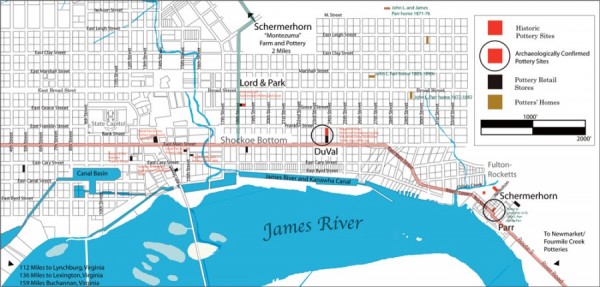
Map of Richmond, Virginia, showing nineteenth-century pottery sites and stoneware retail stores. (Drawn by Oliver Mueller-Heubach.)
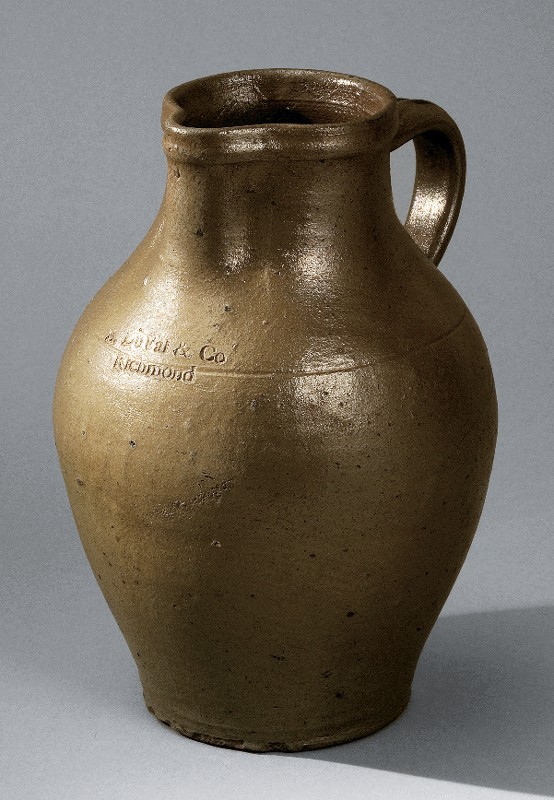
Pitcher, Benjamin DuVal & Co., Richmond, Virginia, 1811–1817. Salt-glazed stoneware. H. 12". Capacity: 1 gallon. Stamped mark: “B. DuVal & Co. / Richmond” (Courtesy, Colonial Williamsburg Foundation.)
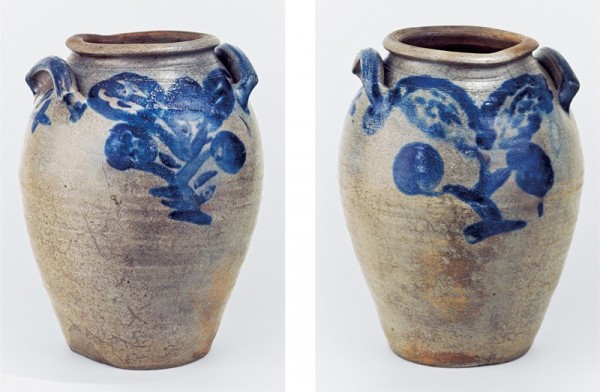
Storage jar, Schermerhorn Pottery, Richmond, Virginia, 1817–1837. Salt-glazed stoneware. H. 15 3/8". Capacity: 4 gallons. Stamped mark: “RICHMOND FACTORY / Virga / J. P. SCHERMERHORN” (Courtesy, Colonial Williamsburg Foundation.)
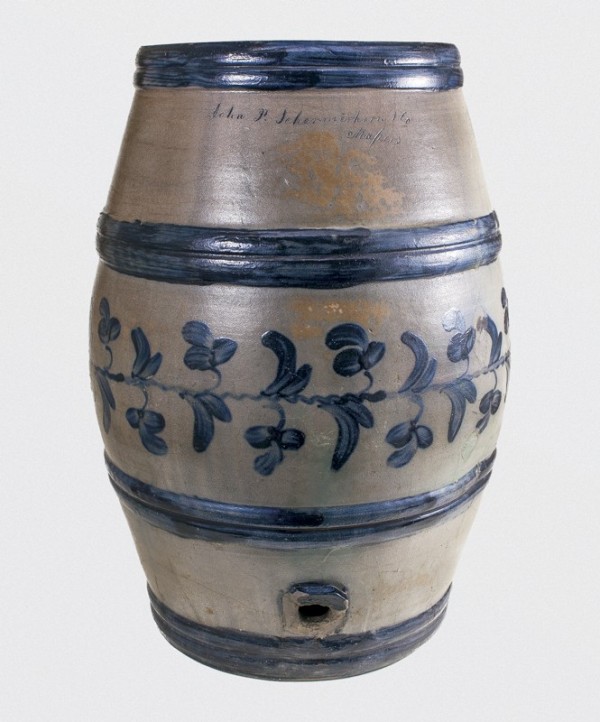
Water or beer cooler, Schermerhorn Pottery, Richmond, Virginia, 1817–1837. Salt-glazed stoneware. H. 27 1/2". Capacity: 30 gallons. Incised marks: [on front] “John P. Schermerhorn & Co./, Makers” (Private collection; photo, Robert Hunter.) This massive cooler was recently discovered in an eastern Virginia estate and may have seen use in a local tavern or business. The form clearly relates to Albany stoneware, whereas the cobalt floral vines recall Baltimore decorative motifs. This is the only known vessel with Schermerhorn’s hand-incised signature.
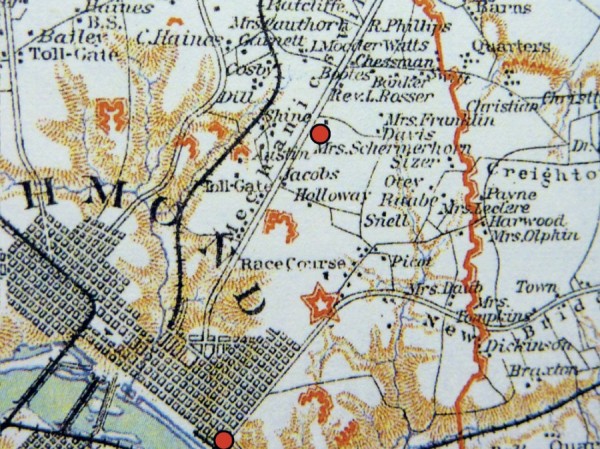
Map showing location of two J. P. Schermerhorn pottery manufactories, one at Rocketts (1817–1837), the other adjacent to his residence at Montezuma (1828–1850), two miles north of Richmond on the Mechanicsville Turnpike. Reproduced from George B. Davis et al., The Official Military Atlas of the Civil War (1891–95; repr., New York: Gramercy Books, 1983), pl. xix, no. 1.
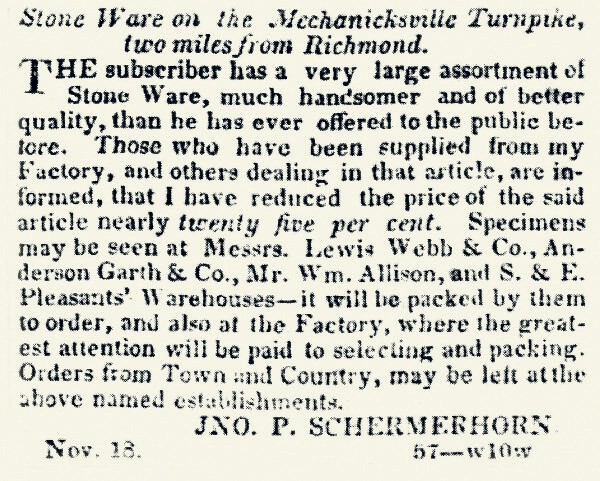
Advertisement identifying J. P. Schermerhorn’s “Mechanicksville Turnpike” stoneware factory. Richmond Enquirer, January 1, 1829, p. 4.
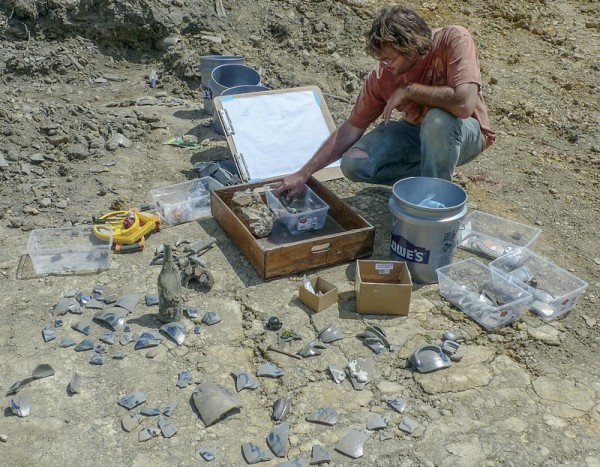
Archeological salvage work at Montezuma, the home and workplace of John P. Schermerhorn, 2010. (Photo, Robert Hunter.) Oliver Mueller-Heubach records evidence and gathers artifacts from Schermerhorn’s pottery, established sometime after his purchase of the land in 1823. According to advertisements, the operation was up and running by 1828.
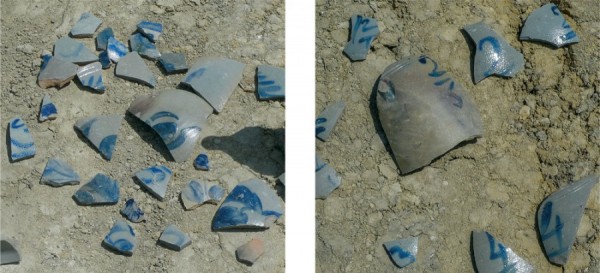
Stoneware fragments, attributed to John P. Schermerhorn, Henrico County, Virginia, 1828–1850. (Private collection; photo, Robert Hunter.) These fragments were found at Montezuma.
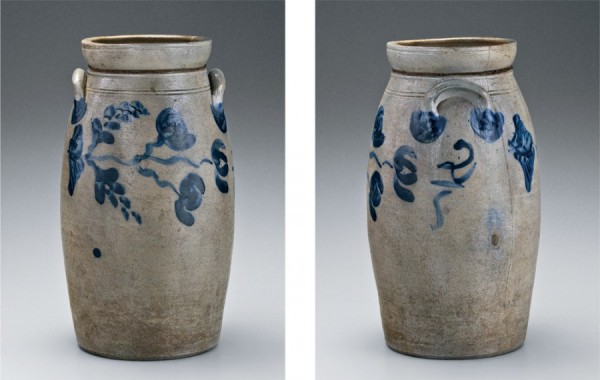
Churn, attributed to John P. Schermerhorn, Henrico County, Virginia, 1828–1850. Salt-glazed stoneware. H. 14 3/4". Capacity: 2 gallons. (Private collection; photo, Gavin Ashworth.)

Storage jar, attributed to John P. Schermerhorn, Henrico County, Virginia, 1828–1850. Salt-glazed stoneware. H. 14 3/4". Capacity: 3 gallons. Inscribed, in brushed cobalt: “A. JACKSON” (Private collection; photo, Gavin Ashworth.) The brushed-cobalt portrait of a bearded Andrew Jackson in military uniform wielding his sword in his right hand dominates the front of the vessel; on the reverse, above the inscription, is Jackson’s profile.
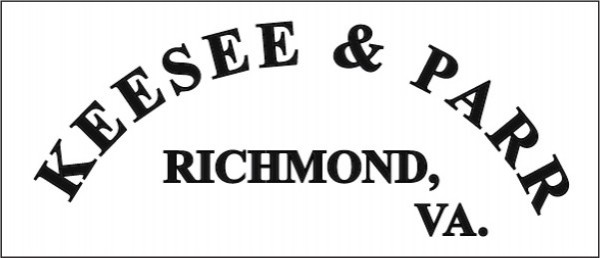
Reconstruction of the stamp used by Keesee & Parr. (Artwork by Oliver Mueller-Heubach.)
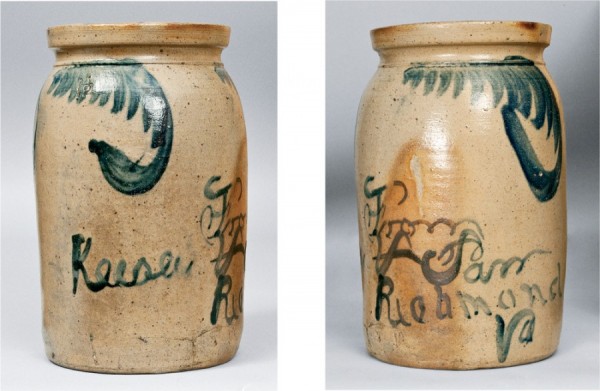
Jar, Keesee & Parr, Richmond, Virginia, 1860–1865. Salt-glazed stoneware, H. 14". Capacity: 3 gallons. Inscribed, in cobalt: “Keesee & Parr / Richmond / Va” (Courtesy, The Valentine; photo, Crocker Farm Auctions.)
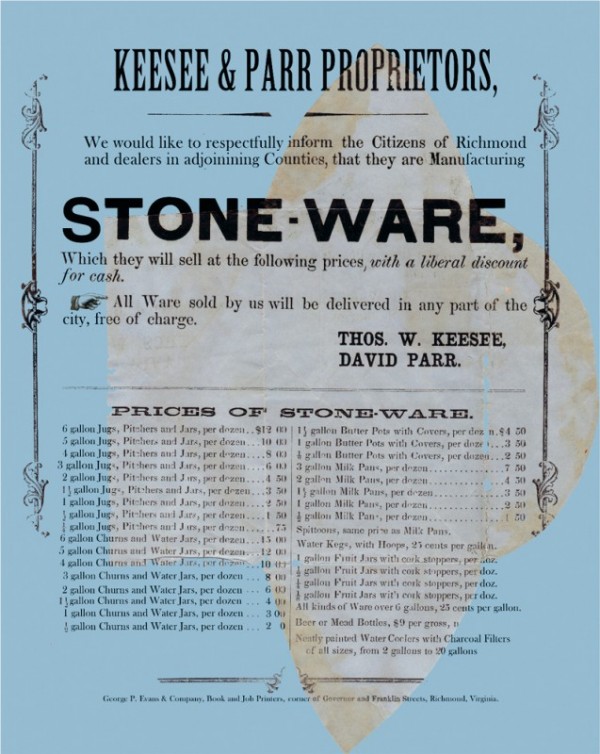
Digital restoration of Keesee & Parr handbill, 1858–1865. (Private collection.) This handbill, printed by George P. Evans and Co. in Richmond, Virginia, details the various forms offered by the business and the price of each. When found, the handbill had been cut and folded to create an envelope, a relic of Richmond’s wartime paper shortage. Two Jefferson Davis stamps were affixed to the outside. It is addressed to Franklin Davis, Loudon County, Virginia, sent by “D. Parr,” whose signature appears in the upper left edge of the envelope.
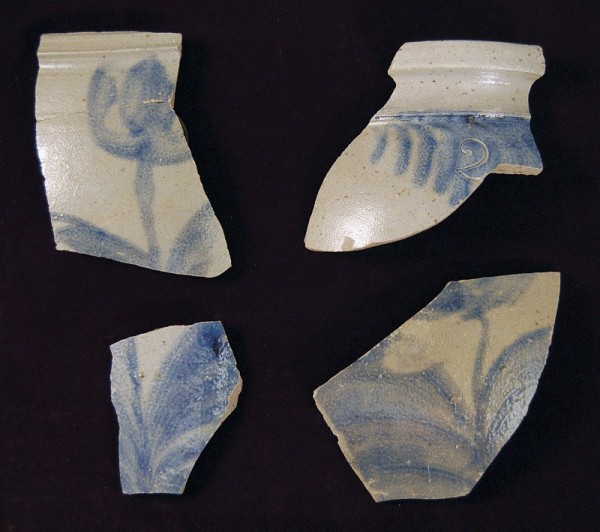
Stoneware fragments from the David Parr Pottery site with flower decoration typically sold under the Keesee & Parr name. (Courtesy, William and Mary Center for Archaeological Research.)
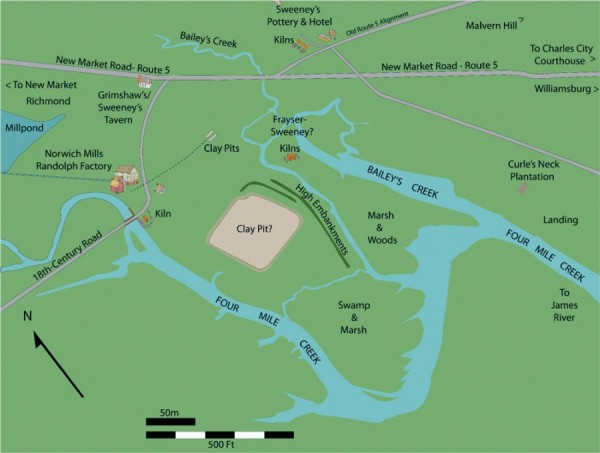
Map showing the Four Mile Creek/Bailey’s Creek area of southeastern Henrico County, Virginia. (Artwork by Oliver Mueller-Heubach.)
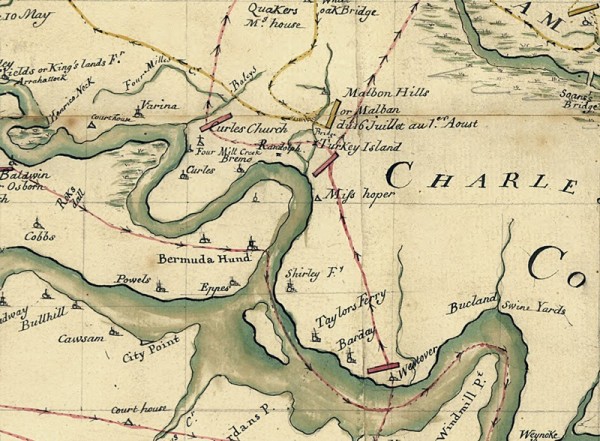
Detail, Campagne en Virginie du Major Général M’is de LaFayette: ou se trouvent les camps et marches, ainsy que ceux du Lieutenant Général Lord Cornwallis en 1781, by Major Michel Capitaine du Chesnoy, aide-de-camp of General LaFayette. (Courtesy, Library of Congress.)
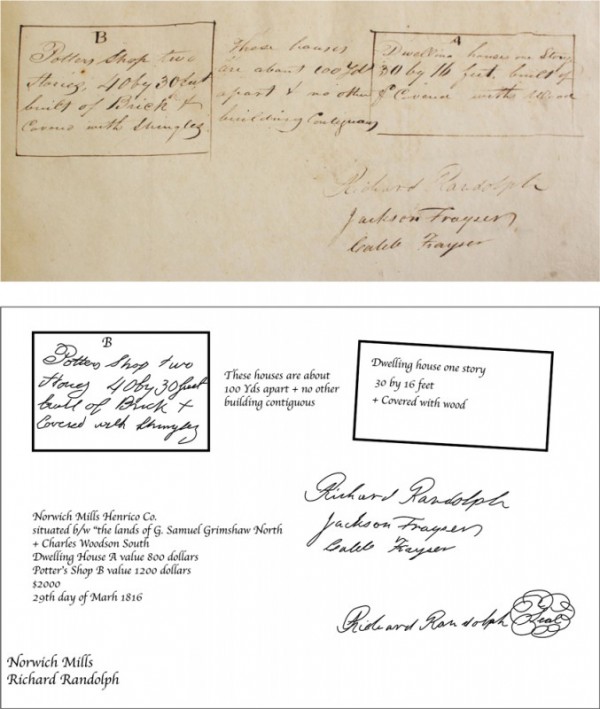
Top: Mutual Assurance Society sketches of insured buildings comprising David Ross’s Norwich Mills complex in 1816. (Courtesy, Library of Virginia.) Bottom: Black-and-white schematic sketch of the insured buildings. (Artwork by Oliver Mueller-Heubach.)
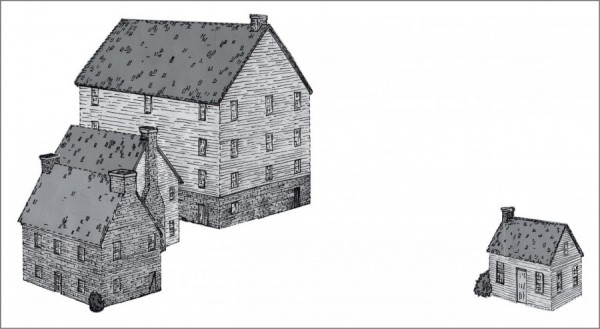
Hypothetical illustration of eighteenth-century Norwich Mills complex showing the buildings on site from the time of Ross’s 1809 transfer (reflecting those insured in 1806) to the evolution or conversion in 1816 of the site to a pottery manufactory (ca. 1812–1813) under Randolph’s ownership. (Artwork by Oliver Mueller-Heubach.)
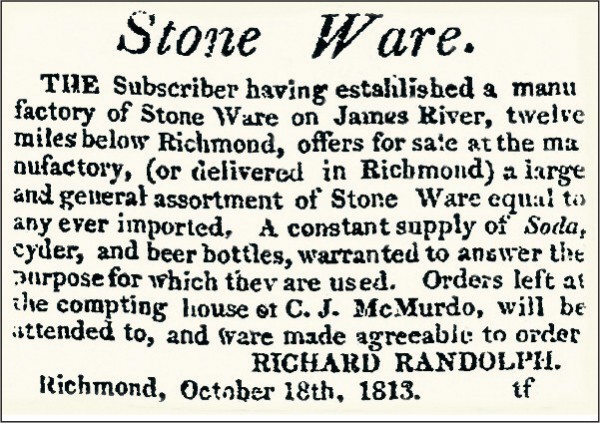
Advertisement for Randolph’s “Soda, cyder, and beer bottles” available for sale at C. J. McMurdo’s “compting house” in Richmond, October 18, 1813. Enquirer, Richmond, October 22, 1813, p. 3-4.
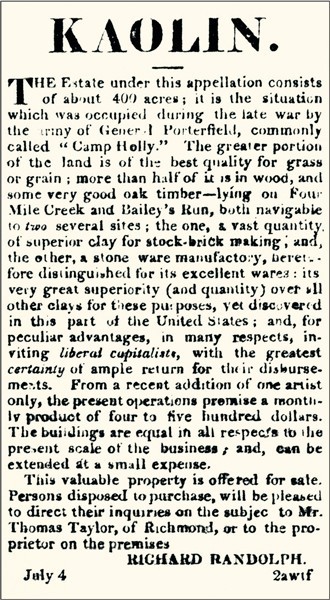
Advertisement for Richard Randolph’s Kaolin estate, July 4, 1817. Enquirer, Richmond, July 4, 1817.

Storage jar fragments, Richard Randolph Manufactory, Four Mile Creek, Henrico County, Virginia, 1813–ca. 1821. Salt-glazed stoneware. Impressed mark: “Richd Randolph / MANUFACTURER” (Private collection; photo, Robert Hunter.) No intact examples of stoneware with this mark are known.
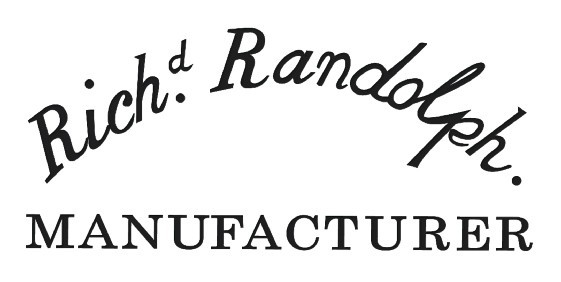
Reconstruction of the Richard Randolph mark. (Artwork by Oliver Mueller-Heubach.)
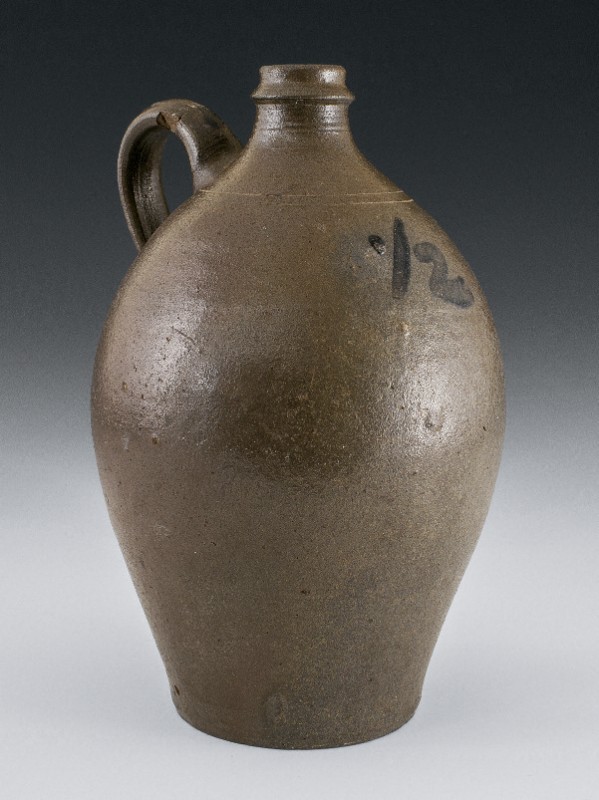
Pottle, attributed to the Richard Randolph pottery, Henrico County, 1813–ca. 1821. Salt-glazed stoneware. H. 9 3/4". (Private collection; photo, Robert Hunter.) The identical lip-and-neck configuration has been found among archaeological collections at Monticello. Those pottles were ordered by Thomas Jefferson in 1814 to hold beer brewed by Peter Hemmings.

Illustration and cross-section of a sea kale pot based on fragments recovered from Monticello and now attributed to Thomas Amoss’s production at the former Randolph pottery on Four Mile Creek in southeastern Henrico County, Virginia. (Artwork by Tabitha Lavis.)
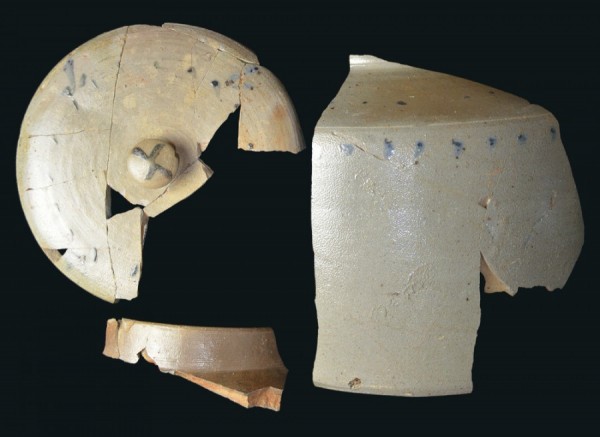
Kale-pot fragments, attributed to Thomas Amoss, Henrico County, Virginia, 1818–1822. Salt-glazed stoneware. (Courtesy, Department of Archaeology, Monticello; photo, Kurt Russ.) Note the cobalt slip decoration of dots and sea kale sprouts around the circumference and the top of the lid. The clay and the style of the cobalt slip application match Amoss’s production at Four Mile Creek.
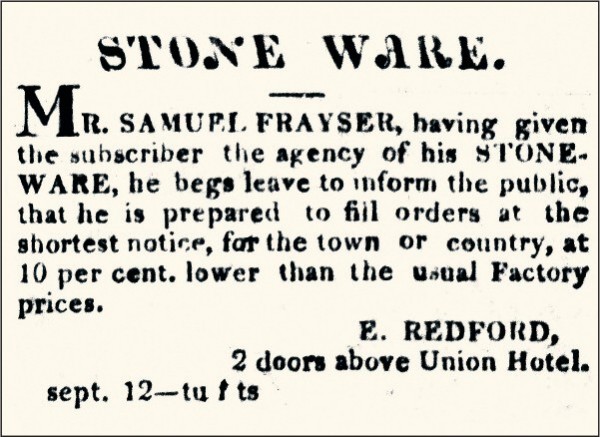
E. Redford advertisement for Frayser stoneware appearing in the Richmond Commercial Compiler, September 12, 1820, p. 3-5.
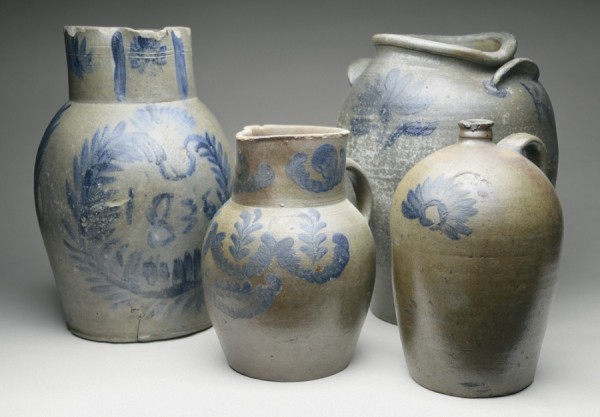
Vessels, attributed to Samuel Frayser, Henrico County, Virginia, 1817–1849. Salt-glazed stoneware. H. of tallest 15". The largest pitcher is dated 1836. (Private collections; photo, Kurt Russ.) The storage jar has a brushed-cobalt capacity mark, “4,” under one handle and a “K” beneath the other.
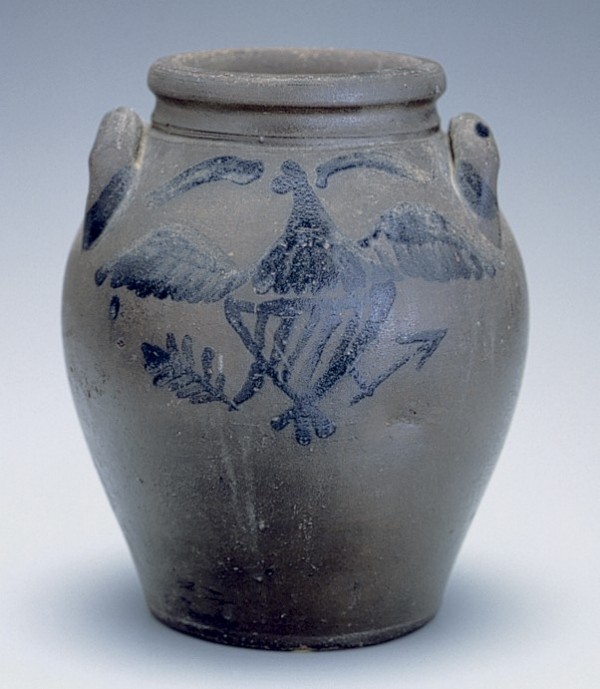
Storage jar, attributed to Samuel Frayser, Henrico County, Virginia, 1817–1849. Salt-glazed stoneware. H. 10". Capacity: 1 gallon. (Private collection; photo, Gavin Ashworth.) This ovoid storage jar displays a similar eagle on the reverse, but that version has olive branches in both talons.
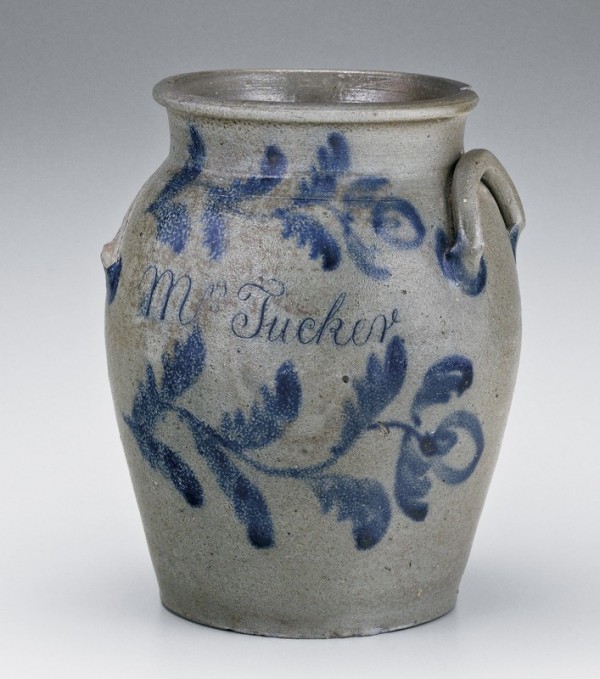
Storage jar, attributed to Samuel Frayser, Henrico County, Virginia, 1817–1849, Salt-glazed stoneware. H. 9 5/8". Incised, in script: “Mrs Tucker” (Private collection; photo, Gavin Ashworth.)
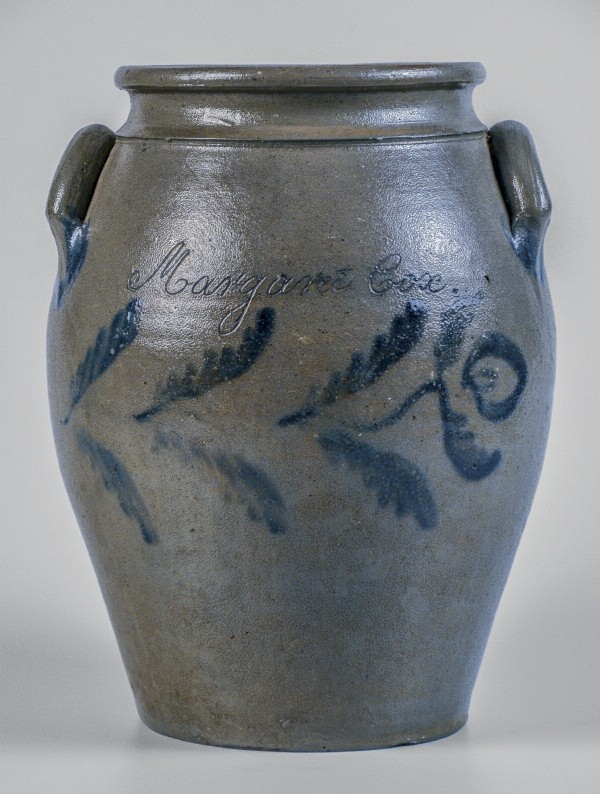
Storage jar, attributed to Samuel Frayser, Henrico County, Virginia, 1817–1849. Salt-glazed stoneware. H. 9 1/2". Incised, in script: “Margaret Cox”; “Quinces” (Courtesy, Virginia Historical Society; photo, Kurt Russ.) The cobalt floral decoration matches that on the jars illustrated in figs. 30 and 33.
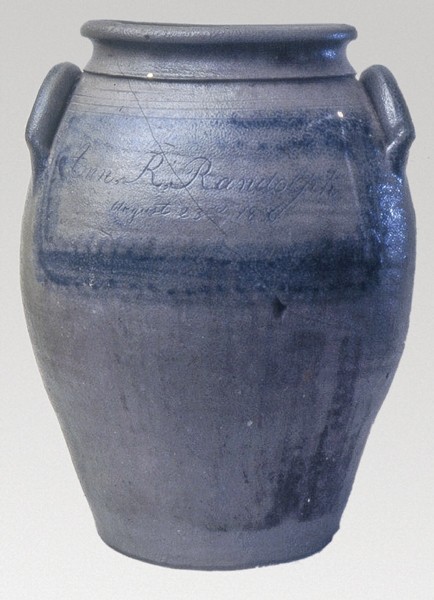
Storage jar, attributed to Samuel Frayser, Henrico County, Virginia, 1817–1849. Salt-glazed stoneware. H. not recorded. Capacity: 1 gallon. Incised, in script: “Ann R. Randolph / August 23, 1836” (Photo, courtesy MESDA Research Files.) Although the form of this jar matches those illustrated in figs. 31 and 33, including the sharp, slightly raised lip or ridge at the base of the neck, the decoration decidedly does not. The broadly amorphous brushed florals were executed by a different decorator.
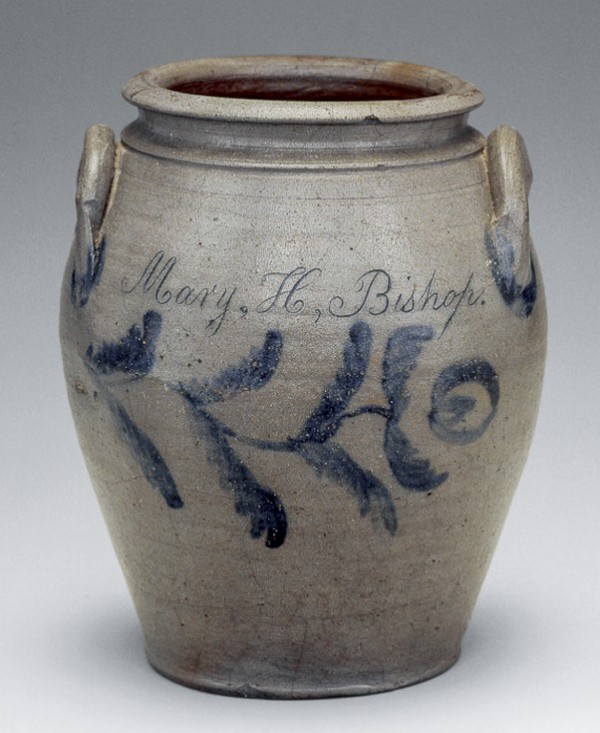
Storage jar, attributed to Samuel Frayser, Henrico County, Virginia, 1817–1849. Salt-glazed stoneware. H. 9 1/4". Incised and highlighted with cobalt: “Mary H. Bishop” (Private collection; photo, Gavin Ashworth.)
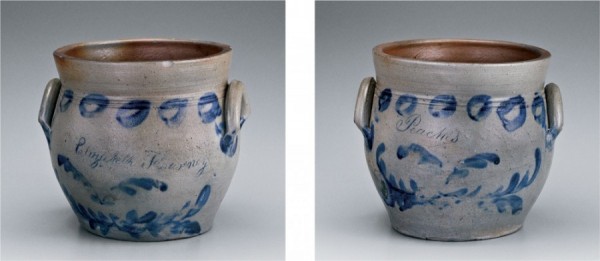
Storage jar, attributed to Samuel Frayser, Henrico County, Virginia, 1817–1849. Salt-glazed stoneware. H. 8". Incised: (front) “Elizabeth Flournoy”; (reverse) “Peaches” (Private collection; photo, Gavin Ashworth.)

Storage-jar fragment, attributed to Samuel Frayser, Henrico County, Virginia, 1817–1849. Salt-glazed stoneware. Partial inscription: “Fussell & Elyson” (Private collection; photo, Robert Hunter.)

Jar fragment, attributed to Samuel Frayser, Henrico County, Virginia, 1817–1849. Salt-glazed stoneware. (Private collection; Robert Hunter.) Note the horizontal undulating-vine decoration.
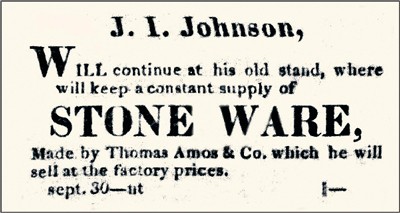
J. I. Johnson advertisement in the Richmond Commercial Compiler, September 30, 1819, p. 3-3.
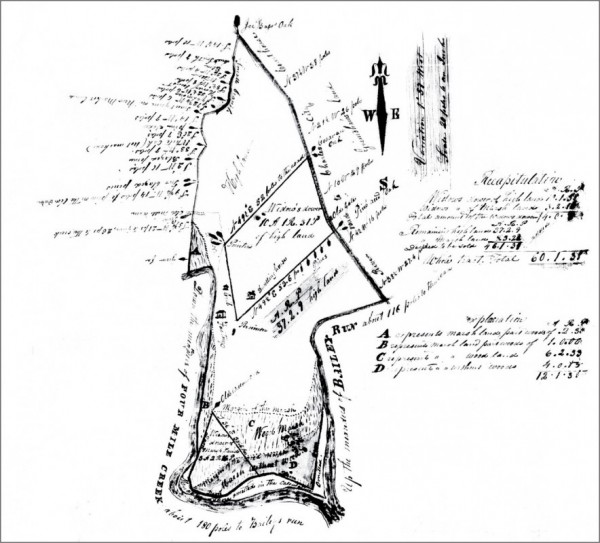
1841 survey of Factory Tract, land owned by Richard Ellyson. (Courtesy, Library of Virginia.)
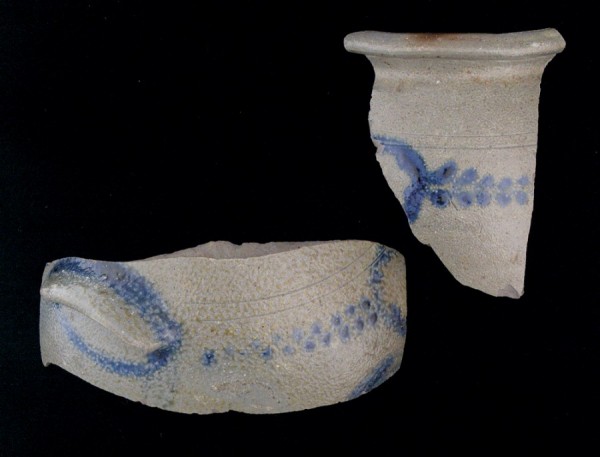
Fragments, attributed to the Thomas Amoss pottery, Henrico County, Virginia, 1818–1823. Salt-glazed stoneware. (Courtesy, Virginia Department of Historic Resources; photo, Robert Hunter.) These archaeologically recovered sherds from the Henrico County site show rim, handle, and decoration matching those on locally discovered vessels.
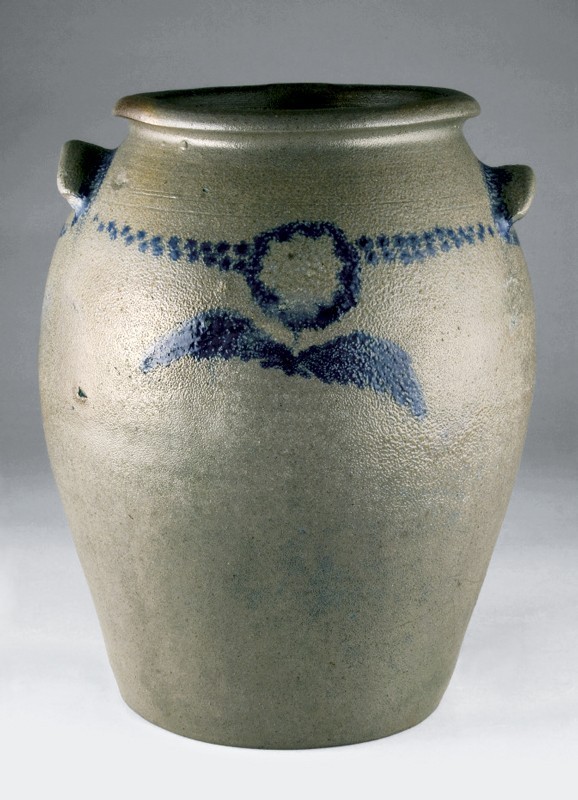
Storage jar, attributed to Thomas Amoss, Henrico County, Virginia, 1818–1822. Salt-glazed stoneware. H. 12 1/2". (Courtesy, Colonial Williamsburg.)
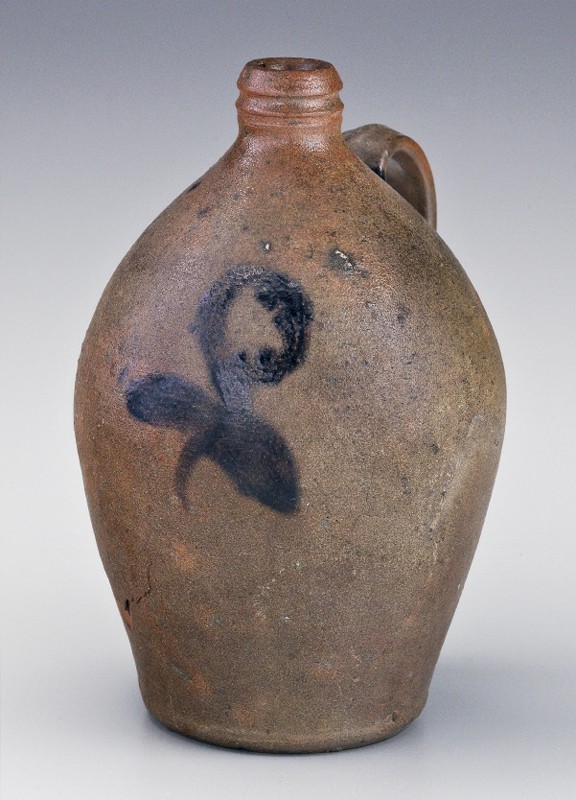
Jug, attributed to Thomas Amoss, Henrico County, Virginia, 1818–1823. Salt-glazed stoneware. H. 10". (Private collection; photo, Gavin Ashworth.)
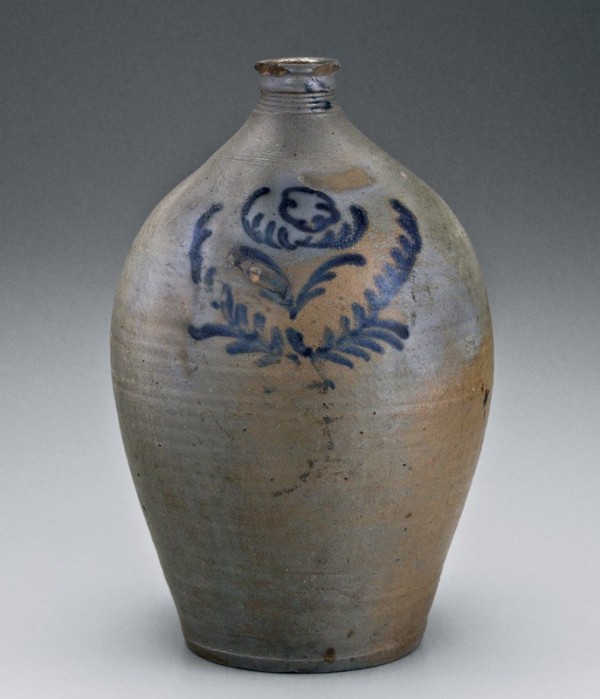
Jug, attributed to Thomas Amoss, Henrico County, Virginia, 1818–1823. Salt-glazed stoneware. H. 15 5/8". (Private collection; photo, Gavin Ashworth.)

Collection of salt-glazed stoneware wasters, Henrico County, Virginia, 1818–1849. (Photo, Oliver Mueller-Heubach.) The variety of forms and decorative treatments help differentiate the makers. Amoss, Frayser, and other potters are represented in these examples.
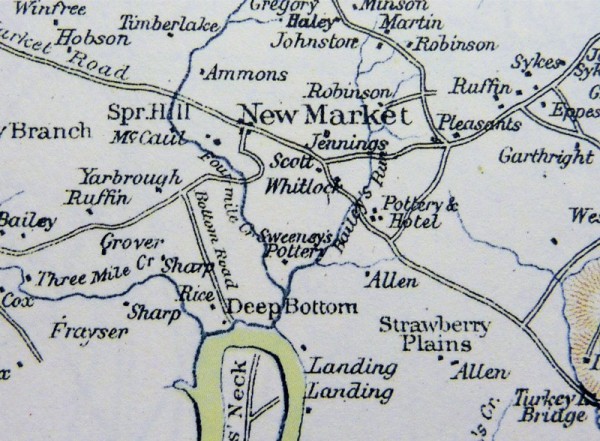
Detail, “Map of Southeast Virginia,” 1862, U.S. Department of the Army, showing the location of both Sweeney’s pottery of ca. 1844–1863, labeled “S. Sweeney’s Pottery,” between and just above the forks of Four Mile Creek and “Bailey’s Run,” and Sweeney’s “Pottery and Hotel,” shown just to the northeast of New Market Road. George B. Davis et al., The Official Military Atlas of the Civil War (1891–95; repr., New York: Gramercy Books, 1983).
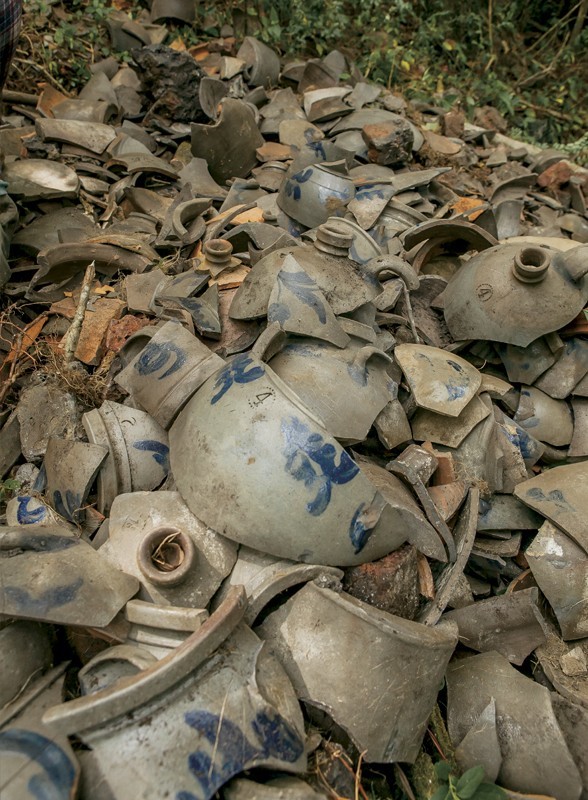
Salt-glazed stoneware fragments at the Stephen B. Sweeney pottery site. (Photo, Robert Hunter.)

Jug, attributed to Samuel Frayser, Henrico County, Virginia, 1817–1849. Salt-glazed stoneware. H. 15 3/8". Capacity: 3 gallons. (Private collection; photo, Gavin Ashworth.) The concave neck with concentric reeding is common in the archaeological specimens from Four Mile Creek made by Frayser and Amoss, while the floral decoration is common to Frayser-attributed wares and likely precursors to later Sweeney motifs.

Churn, attributed to Stephen B. Sweeney, Henrico County, Virginia, 1838–1863. Salt-glazed stoneware. H. 21 7/8". Capacity: 5 gallons. (Private collection; photo, Gavin Ashworth.)
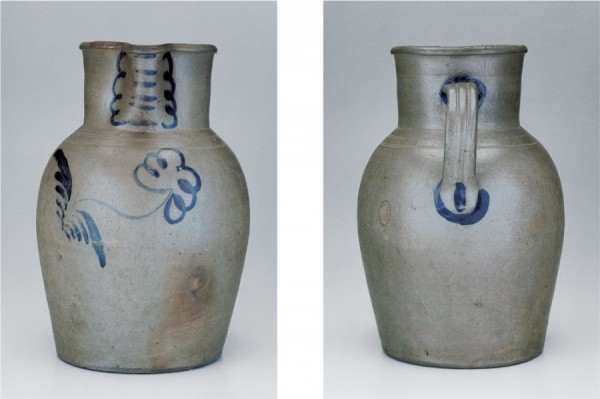
Pitcher, attributed to Stephen B. Sweeney, Henrico County, Virginia, 1838–1863. Salt-glazed stoneware. H. 17 1/2". Capacity: 3 gallons. (Private collection; photo, Gavin Ashworth.)
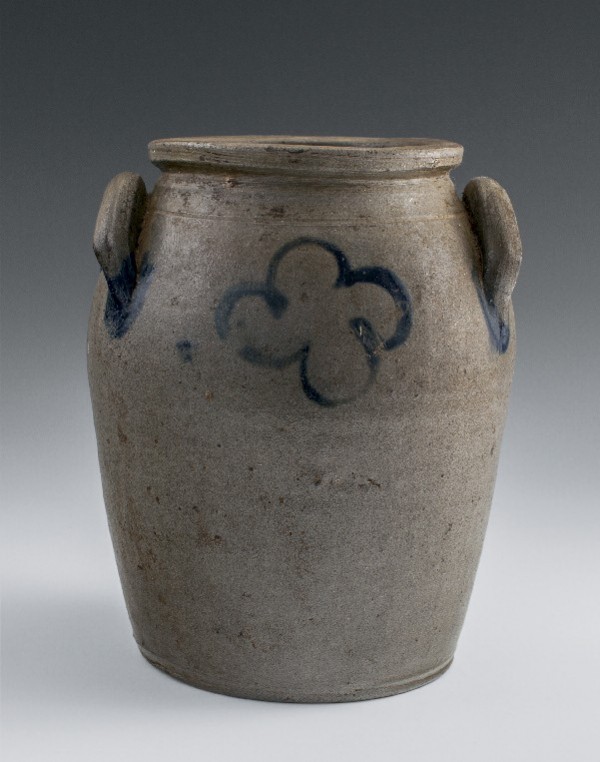
Jar, attributed to Stephen B. Sweeney, Henrico County, Virginia, 1838–1863. Salt-glazed stoneware. H. 9". Capacity: 1 gallon. (Private collection; photo, Robert Hunter.)
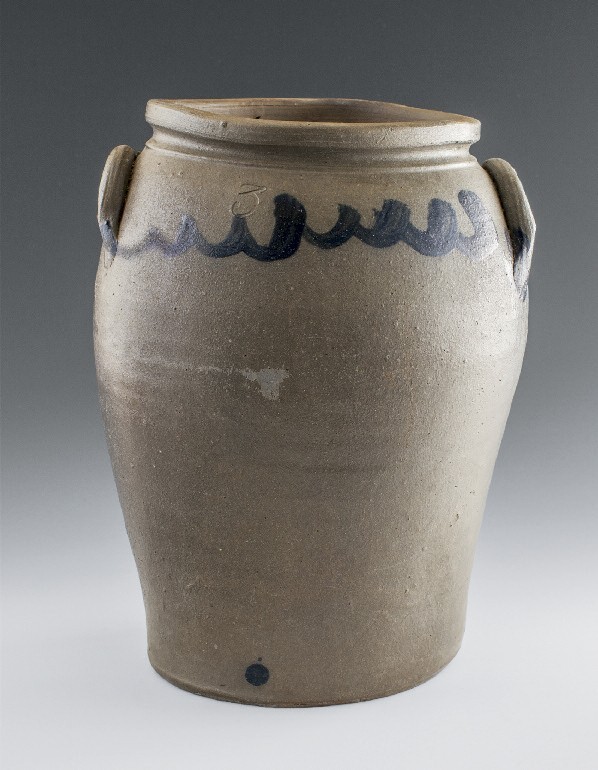
Jar, Stephen B. Sweeney, Henrico County, Virginia, 1838–1863. Salt-glazed stoneware. H. 14". Capacity: 3 gallons. (Private collection; photo, Robert Hunter.)
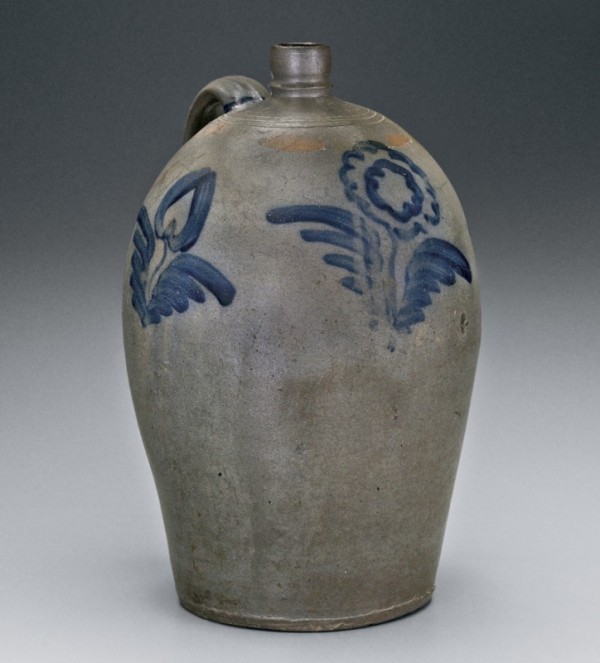
Jug, Stephen B. Sweeney, Henrico County, Virginia, 1838–1863. Salt-glazed stoneware. H. 16 1/2". Capacity: 3 gallons. (Private collection; photo, Gavin Ashworth.) The blossom configuration of the brushed blue-cobalt floral motif on the front of this jug was undoubtedly influenced by Amoss. The blossoms of the lateral flanking motifs are more common in the Sweeney decorative repertoire.
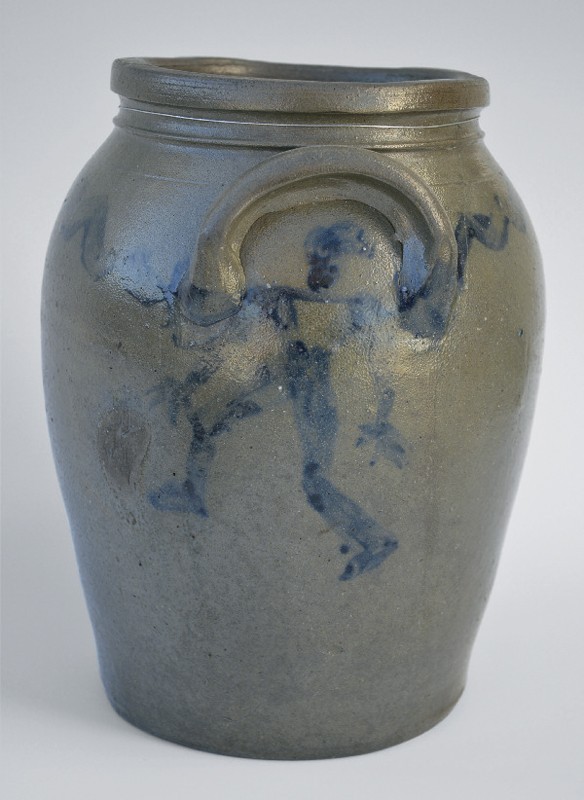
Storage jar, attributed to Stephen B. Sweeney, Henrico County, Virginia, 1838–1863. Salt-glazed stoneware. H. 9 1/2". Capacity: 1 gallon. (Private collection; photo, Kurt Russ.) The decorative motif is a brushed-cobalt dancing man beneath one of the handles.
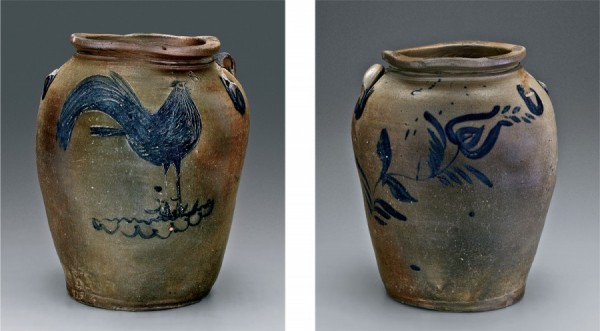
Storage jar, attributed to Stephen B. Sweeney, Henrico County, Virginia, 1838–1863. Salt-glazed stoneware. H. 15". Stamped capacity mark: “5” (Private collection; photo, Gavin Ashworth.) This ovoid vessel displays a well-defined incised and cobalt-filled rooster, or game cock, standing on cobalt festoons similar to those seen on other Sweeney and Schermerhorn vessels, such as the jar illustrated in Russ and Schermerhorn, “Rocketts’ Red Glare,” p. 72, fig. 14.

Storage-jar fragment, attributed to Stephen B. Sweeney, Henrico County, Virginia, 1838–1863. Salt-glazed stoneware. (Private collection; photo, Robert Hunter.)
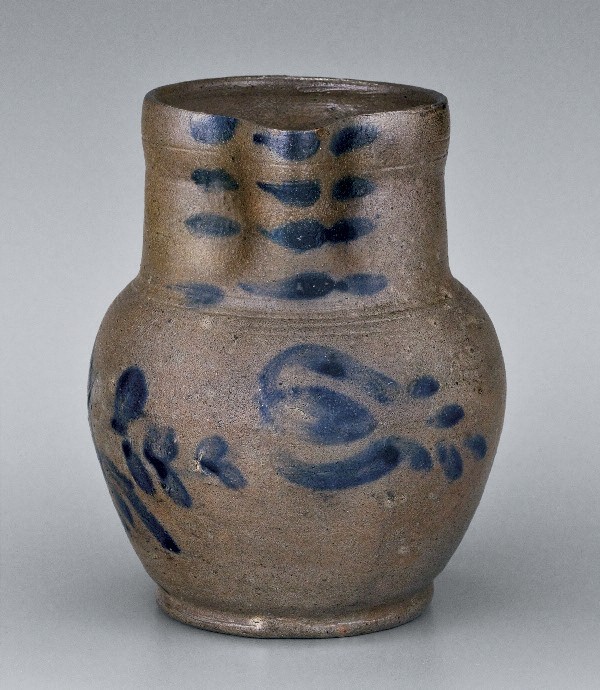
Pitcher, Stephen B. Sweeney, Henrico County, Virginia, 1838–1863. Salt-glazed stoneware. H. 6 3/8". (Private collection; photo, Gavin Ashworth.)
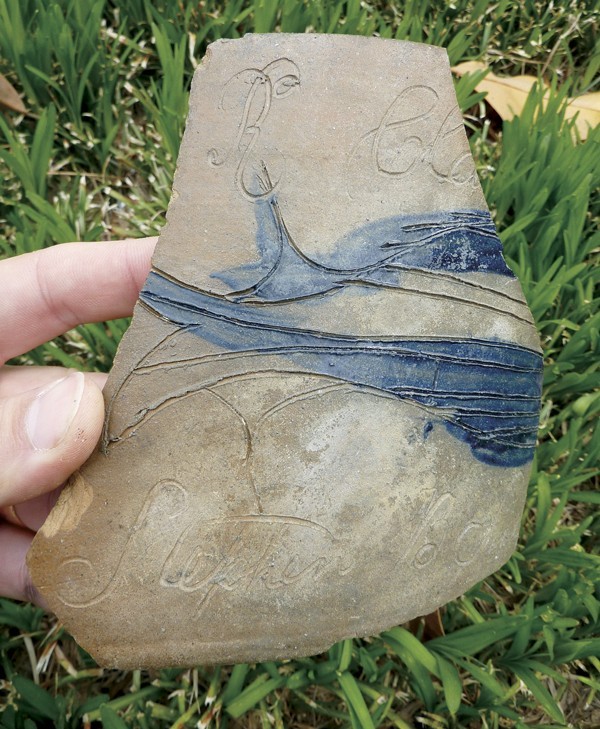
Butter-crock fragment, Stephen B. Sweeney, Henrico County, Virginia, 1838–1863. Salt-glazed stoneware. Inscribed: “R. Cla . . .”; “Stephen B. Swe . . .” (Private collection; photo, Oliver Mueller-Heubach.) The decoration on this waster fragment is a fish or a bird between the incised inscription and Sweeney’s partial signature. Speculation on what the inscription refers to includes names of local families, such as Claiborne or Clay, or of a nearby landowner, Clarke.
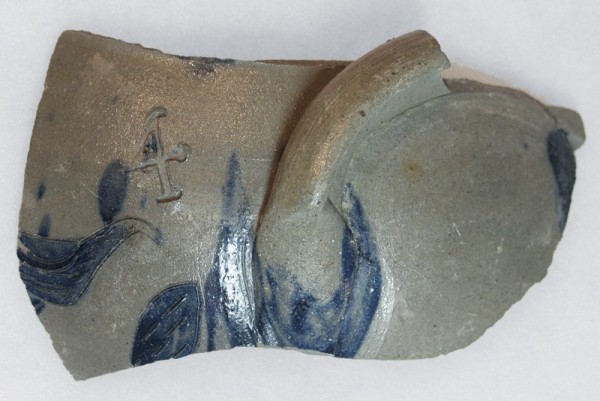
Storage-jar fragment, Stephen B. Sweeney, Henrico County, Virginia, 1838–1863. Salt-glazed stoneware. (Private collection; photo, Oliver Mueller-Heubach.) Incised and cobalt-filled bird and floral decoration embellishes this shoulder remnant from a four-gallon jar.

Storage jar, attributed to Samuel Wilson and/or associates, Richmond, Virginia, 1817–1850. Salt-glazed stoneware. H. 14 1/2". Capacity: 3 gallons. Incised on base: “Richmond” (Private collection; photo, Gavin Ashworth.)
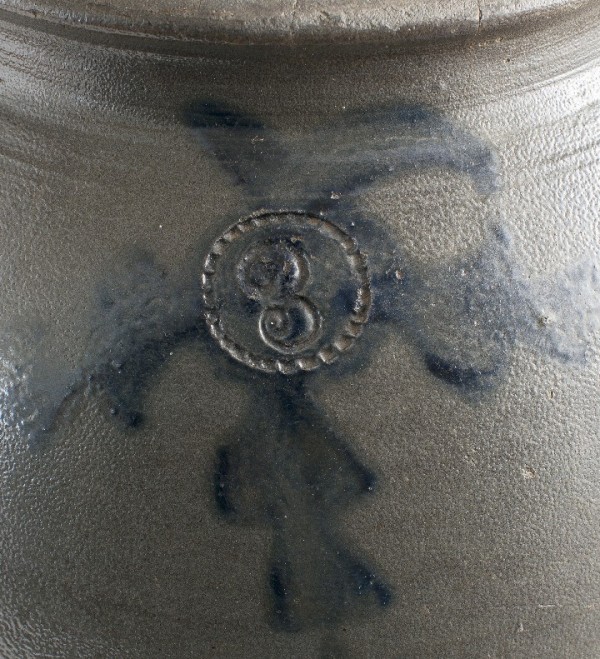
Detail showing the capacity mark on the jar illustrated in fig. 58. The distinctive capacity mark distinguishes these Group I wares attributed to Samuel Wilson working with John Schermerhorn.
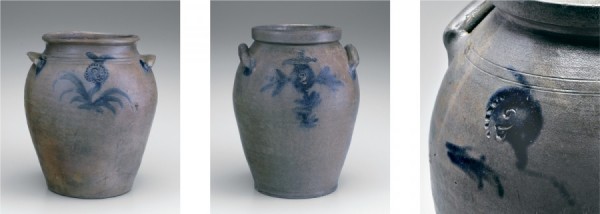
Storage jars, attributed to Samuel Wilson and/or associates, Richmond or Henrico County, Virginia, 1817–1850. Salt-glazed stoneware. H. (left) 11 1/4"; (middle, right) 12 1/2". Capacity: 2 gallons. (Private collection; photo, Gavin Ashworth.)

Storage jar, attributed to Samuel Wilson and/or associates, Richmond or Henrico County, Virginia, 1817–1850. Salt-glazed stoneware. H. 15 1/2". (Private collection; photo, Gavin Ashworth.)
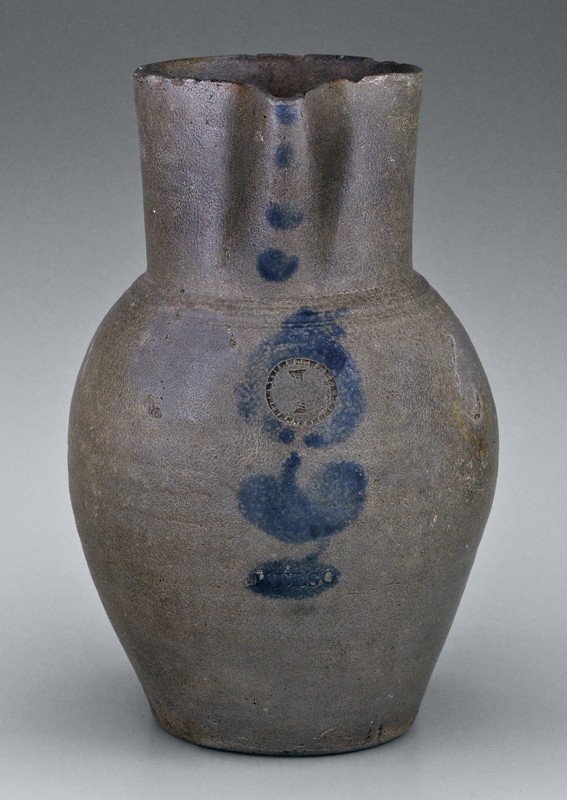
Pitcher, attributed to Samuel Wilson and/or associates, Richmond or Henrico County, Virginia, 1817–1850. Salt-glazed stoneware. H. 11 1/8". Capacity: 1 gallon. Impressed: “KELSO” (Private collection; photo, Gavin Ashworth.) The floral decoration is virtually identical to that on the jar illustrated in fig. 63 (right).
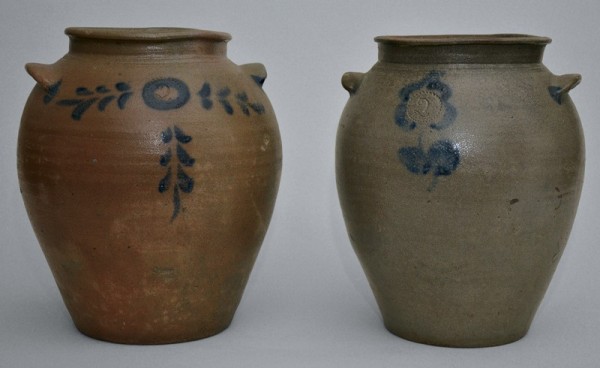
Storage jars, attributed to Samuel Wilson and/or associates, Richmond or Henrico County, Virginia, 1817–1850. Salt-glazed stoneware. H. of jar on right 11 7/8". (Private collection; photo, Kurt Russ.)
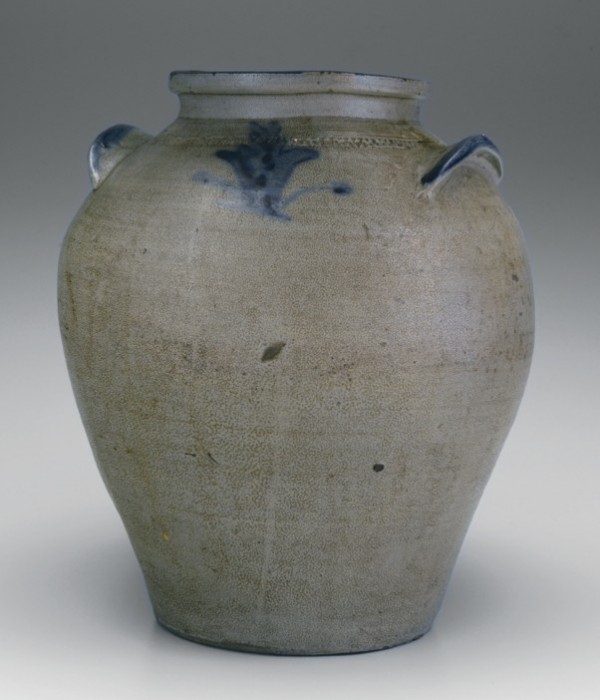
Storage jar, attributed to Samuel Wilson and/or associates, Richmond or Henrico County, Virginia, 1817–1850. Salt-glazed stoneware. H. 14 1/2". (Private collection; photo, Gavin Ashworth.)
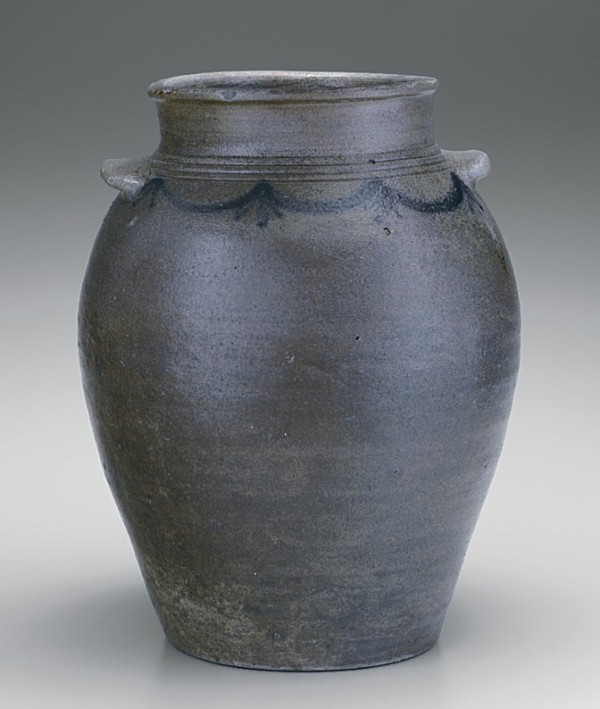
Storage jar, attributed to Samuel Wilson and/or associates, Richmond or Henrico County, Virginia, 1817–1850. Salt-glazed stoneware. H. 13 3/4". Capacity: 3 gallons. (Private collection; photo, Gavin Ashworth.)
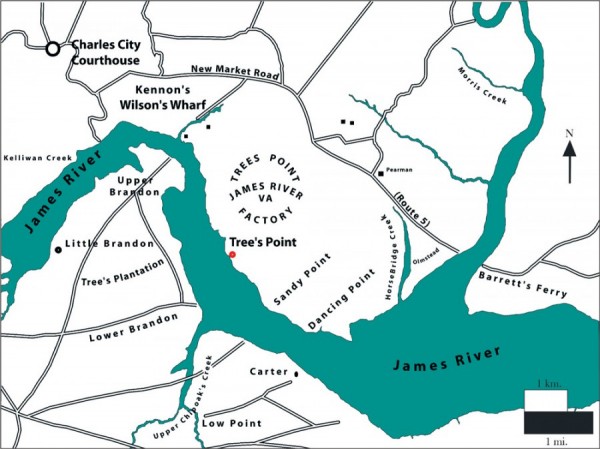
Map showing location of Trees Point Factory. (Courtesy, Oliver Mueller-Heubach.) Wilson’s Landing is to the north in relation to the James River.
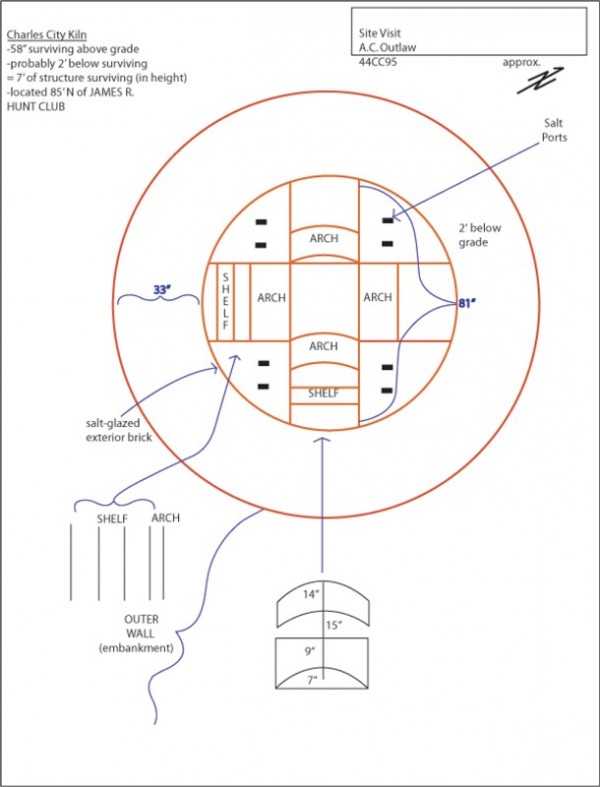
Field sketch or plan of Trees Point Factory kiln (1849–1853) by Alain Outlaw; traced by Oliver Mueller-Heubach.

J. P. Hudson examining the remains of an above-ground kiln, 1978. (Courtesy, Department of Anthropology, College of William and Mary.)

Stoneware fragments, Trees Point Factory, Charles City County, Virginia, 1849–1853. Salt-glazed stoneware. (Courtesy, William and Mary Archaeological Research Center.)

Rendering of maker’s stamp of Trees Point Factory. (Artwork by Oliver Mueller-Heubach.)
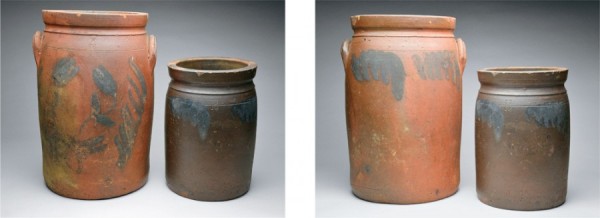
Storage jars, Trees Point Factory, Charles City County, Virginia, 1849–1853. Salt-glazed stoneware. H. 16" and 11 1/2". (Private collection; photo, Kurt Russ.)
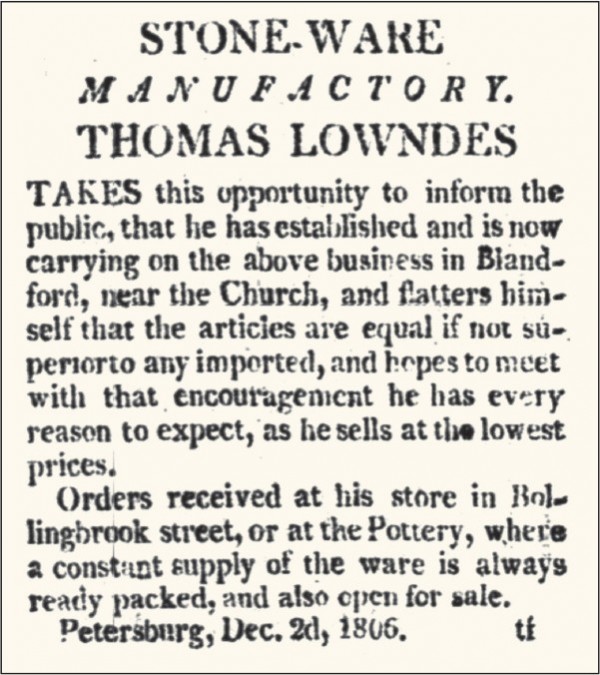
Advertisement, Thomas Lowndes Stone-Ware Manufactory, Petersburg Intelligencer, December 2, 1806, p. 3. This is an important early reference to a transplanted English stoneware concern about which little is known.
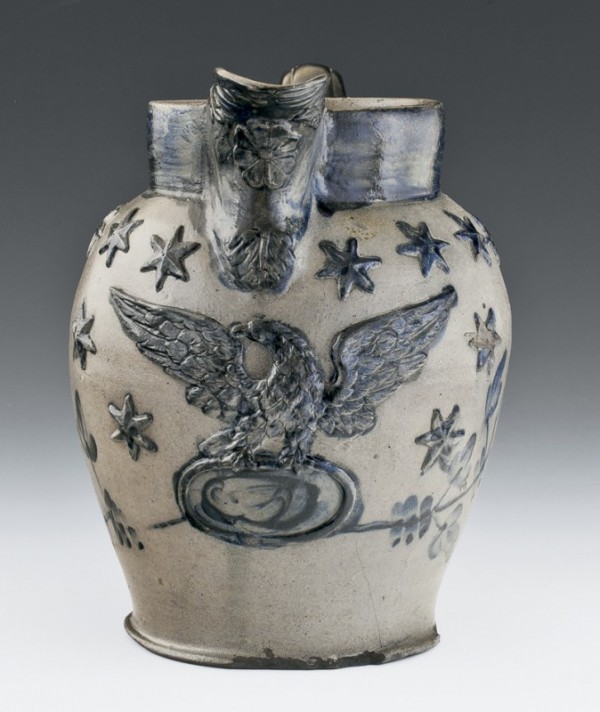
Pitcher, Henry Lowndes, Petersburg, Virginia, 1835–1840. Salt-glazed stoneware. H. 12". (Private collection; photo, Robert Hunter.) The classical shape of this elaborately decorated pitcher is typical of Staffordshire earthenware. The use of applied molding to the spout and the body is also influenced by British prototypes. The spread eagle, wreath, and stars all resemble decorative motifs incorporated in cast-iron decoration of the period. This pitcher is one of only two of this type known to exist.
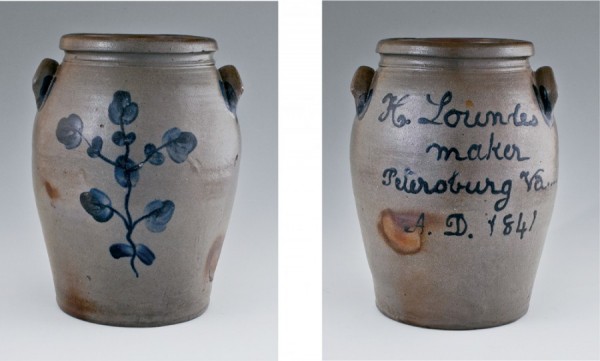
Storage jar, Henry Lowndes, Petersburg, Virginia, 1841. Salt-glazed stoneware. H. 12 1/2". Capacity: 2 gallons. Slip-trailed inscription: “H. Lowndes / maker / Petersburg Va. / A.D. 1841” (Private collection; photo, Robert Hunter.)
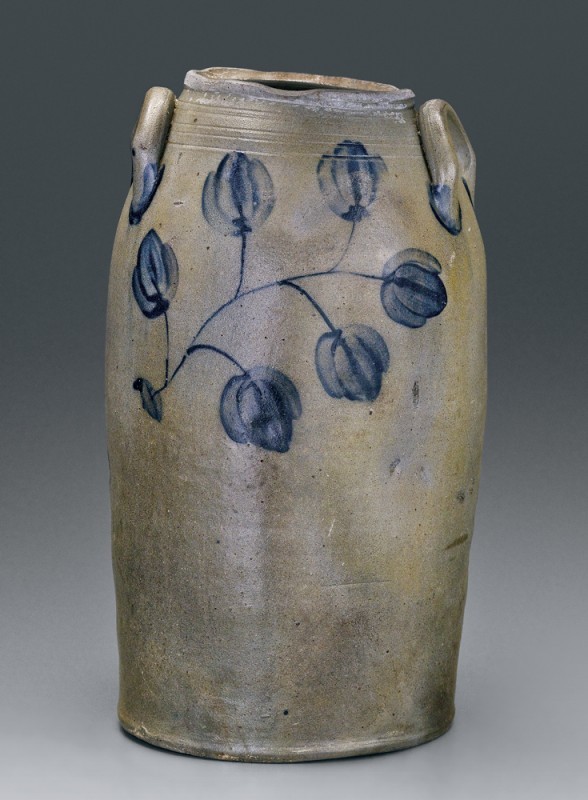
Churn, attributed to Stephen B. Sweeney, Henrico County, Virginia, 1838–1863. Salt-glazed stoneware. H. 17 1/2". (Private collection; photo, Gavin Ashworth.) Extant vessels have recently been identified that appear to have been produced by Sweeney but are decorated with a close variation on the Lowndes so-called Cotton Plant motif (see fig. 74). The branches are asymmetrical and the cotton blooms are less structured, more tightly defined, and sometimes executed with only two brushstrokes. These vessels may suggest an overlap between the two potteries either in the purposeful imitation of decoration or the exchange of workmen.
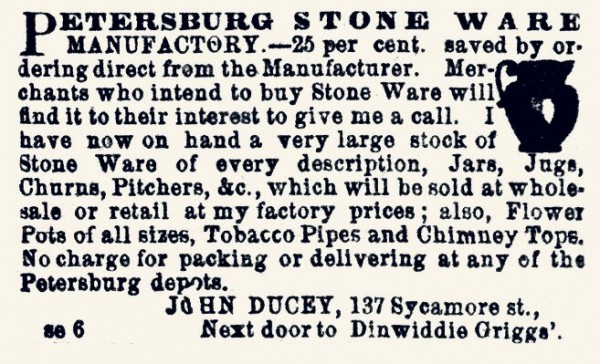
Advertisement for the Petersburg Stone Ware Manufactory, featuring the silhouette of a pitcher resembling earlier Lowndes Staffordshire-style ware. Petersburg Index, September 1872, p. 3, col. 3.
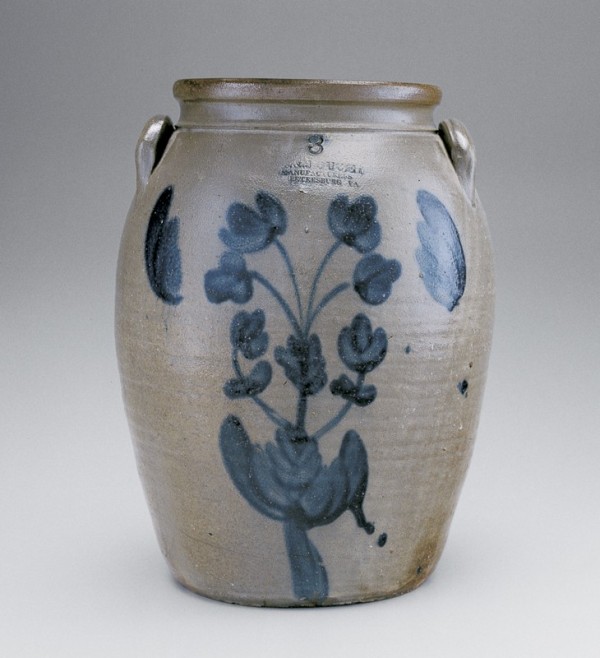
Storage jar, Thomas and John Ducey, Petersburg, Virginia, 1855–1872. Salt-glazed stoneware. H. 15". Capacity: 3 gallons. (Private collection; photo, Gavin Ashworth.) This well-made example of the Duceys’ work displays a deep-cobalt–brushed floral decoration, following the Lowndes style. Although scant research has been conducted on this pottery, a number of examples exist, both marked and unmarked. The mid-nineteenth-century forms tend to be straight-sided or slightly ovoid, typical of the period, although the decoration recalls earlier Lowndes pieces.
